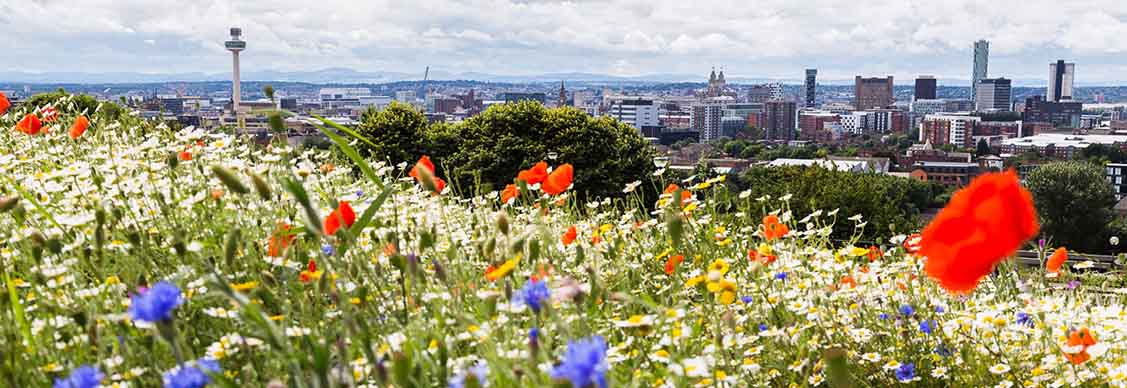How urban greening projects are underpinning sustainable cities
Initiatives to increase green space and improve biodiversity are part of a more holistic sustainability agenda looking beyond decarbonization
Tackling climate change within cities is about more than making buildings net zero; boosting nature and protecting the local wildlife is equally paramount in the drive to build more sustainable and resilient spaces.
Biodiversity, the variety of plant and animal life in a habitat, is a key measure of how healthy a city is.
“Improving biodiversity is part of a more holistic approach to tackling decarbonization, rather than looking at emissions in isolation,” says Jeremy Kelly, Global Research Director, City Futures at JLL.
As cities grapple with the consequences of urbanization, such as urban heat islands, and the effects of climate change, such as drought and flash flooding, a healthy and varied natural ecosystem can mitigate these impacts by sequestering carbon, providing shade and cooling, capturing water run-off and protecting coastlines from erosion.
“We’re facing a global biodiversity crisis that is interconnected with the climate crisis,” says Amanda Skeldon, Director, Climate and Nature at JLL. “As our cities expand and we concrete over our landscape, we’re creating less resilient places that are at greater risk from climate change. Restoring and protecting biodiversity can build resilience.”
In response, many cities increasingly committing to developing more green cover, according to JLL’s Decarbonizing Cities report. Mayors from 31 cities including Los Angeles, Mumbai, Paris, Stockholm and Sydney have signed C40’s Urban Nature Declaration committing to ensure 30-40 percent of total built-up city surface area consists of green or permeable spaces by 2030, and 70 percent of residents can access green (vegetation-based) or blue (water-based) public spaces within a 15-minute walk or cycle.
Amsterdam’s Resilio initiative between city government and eight partners transforms rooftops into ‘blue-green’ roofs with greenery and rainwater storage, relieving the drainage system while cooling during droughts.
“Collaboration across sectors is the only way cities can restore nature at a level that truly benefits people and the environment. This requires commitment from investors, property owners, local authorities and businesses,” says Skeldon.
Thinking big
Forward-thinking developers and landlords are incorporating green infrastructure such as living walls, outdoor green space and rooftop beehives, and embedding biodiversity. Central London’s largest property owners have formed the Wild West End partnership to build a green corridor while Berkeley Group’s Green Quarter in the west of the city is part of a commitment by the developer to create 450 acres of new or improved habitat.
Scalable solutions are critical. In Melbourne, which plans to increase canopy cover from 22 percent to 40 percent by 2040, the Urban Forest Fund provides grants for greening projects such as green roofs, to help drive uptake on buildings and larger developments.
“Green spaces enhance the liveability of a city,” says Rupert Davies, Sustainability Consultant, at JLL. “This will be increasingly important to a city’s competitiveness as businesses settle into hybrid and remote work and personal wellbeing becomes a priority.”
Local residents equally benefit from improved air quality, reduced noise from traffic and better mental and physical health from a stronger connection to nature.
As awareness around the advantages grows, so does demand for buildings that embrace biophilic design and greenery.
“Integrating biodiversity, especially in larger developments, will attract occupiers and enhance overall asset value, so there’s a financial incentive that may not have been there a decade ago,” says Davies.
Yet today’s decision-making needs to look far beyond shorter-term gains. “There’s an opportunity to significantly improve quality of life as well as business revenues by creating cities that are truly more liveable and sustainable over the long term because they are more resilient to climate change,” Skeldon says. “This resilience is what the real estate companies – alongside cities – need to target, rather than simply responding to market demand or to get ahead of legislation.”
Shaping the future
Forthcoming regulations will impact how developments are built.
An EU policy to reduce soil threats such as landslides and floods will limit the amount of concrete used on surfaces. “This will restrict city expansion, and particularly impact the design of logistics space,” says Kelly.
From early 2024, the UK’s Biodiversity Net Gain legislation will require new developments to leave biodiversity in a better state than before.
However, with 80 percent of UK buildings that will exist in 2050 already built, there has been a push for stronger guidance and frameworks to address nature-positivity for the existing built environment and the sector more broadly.
A raft of new global guidance on nature has emerged in the last 12 months including the final Taskforce on Nature Related Financial Disclosure (TNFD) recommendations for nature-related risk management and disclosure, and science-based targets for nature which provide specific sector guidance to help businesses set relevant targets around nature.
Key to the built environment is guidance towards a nature-positive future from Business for Nature. These all provide frameworks, metrics and recommendations on how businesses can take action from understanding risk to setting targets and taking credible action.
“It is great to see greater consensus and guidance on what action the built environment can take to accelerate a just transition to a nature-positive, resilient, net-zero future. We still need pioneering measures at a city level to inform strong legislation,” says Skeldon.
City governments that develop voluntary public-private partnerships have an edge in driving large-scale innovation that can guide urban planning in other cities.
“Biodiversity is critical for cities to address if they are to build resilience against the climate impacts that could make them unliveable,” says Kelly. “Those with true collaborations between the public and private sectors will be better placed to develop robust frameworks of funding, incentives, education and advocacy that can drive city-level change and encourage stakeholders to proactively contribute to sustainability targets.”
